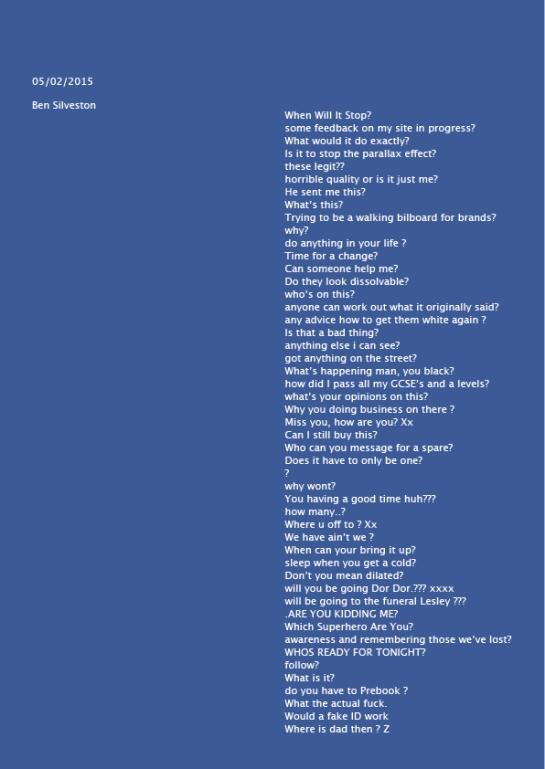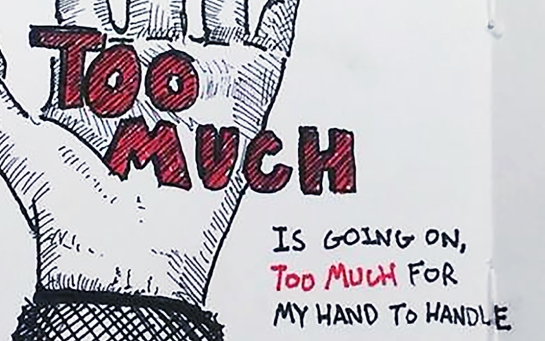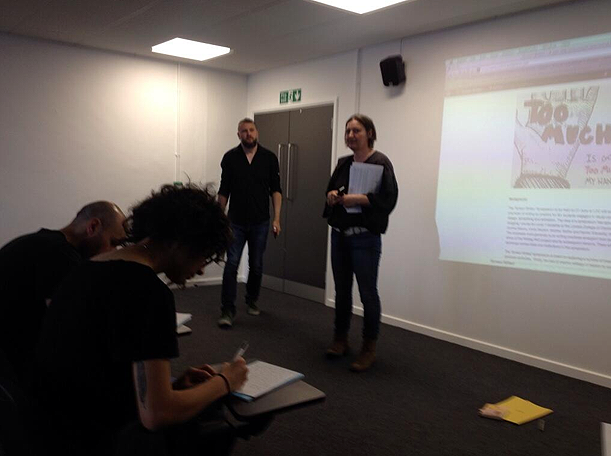
The inaugural Screen Writes Symposium was sponsored by London College of Communication, Higher Education Academy and the Writing PAD network.
To kick start the symposium Andrea Mason and I conducted one of the writing workshops that we gave to LCC students in January.
I then delivered a presentation: Looking after the Selfie: Graphic Design and Writing:
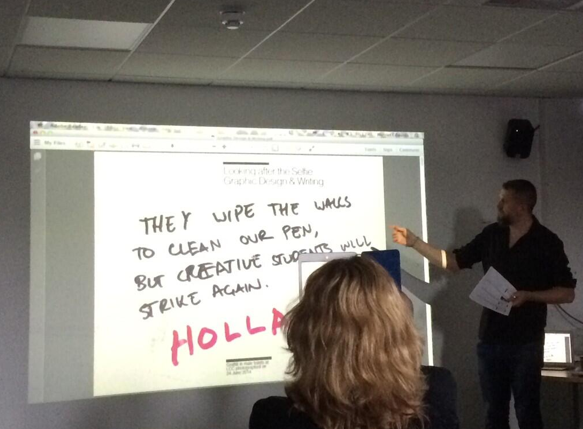

The basis of graphic design is the relationship of text and image. Here is some text that fits in with the overall theme of this presentation, in that I regard writing as essential to the creative act. This presentation is written very much in the first person, from the perspective of a student, a practitioner, a writer and an educator within the discipline of design.

Here is an image, male toilet walls provide a creative canvas for both text and image, the images are often limited in their subject. Drawing and writing are both essential to the development of the visual and verbal inquiry of the design practitioner, both however, based on experience, can be regarded by some students as irrelevant.

Here I am with my degree show work. The Swiss modernist teachings atRavensbourne from the mid 1960s to the mid 1990s focused student’s attention on both content and form where hierarchies, both written and visual, were learnt in a systematic way.
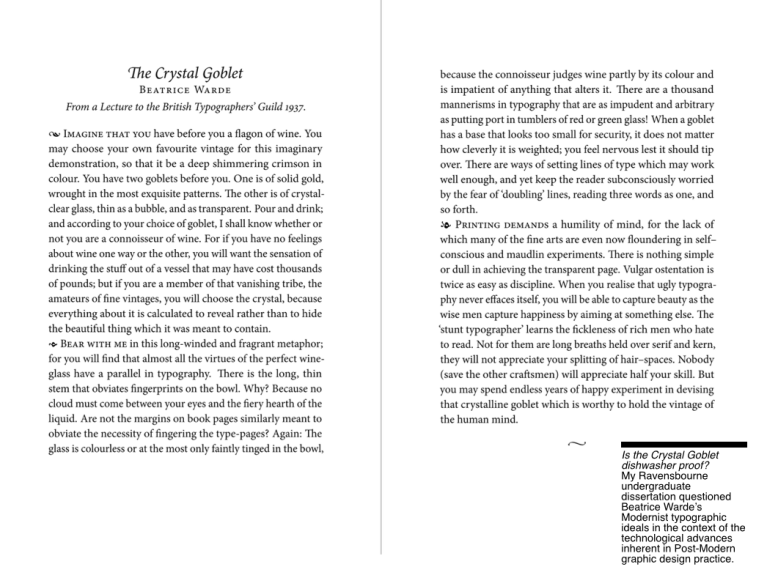
In the early 1990s, most acutely by students at Ravensbourne and Central Saint Martins, there was a wave of experimental typography that captured the technological transformation of graphic design processes. Beatrice Warde’s 1930 speech to The British Typographers Guild ‘Printing should be invisible’ provided the subject for my undergraduate dissertation. Warde use the metaphor of a Crystal Goblet to champion content over form, and as a consequence elevating the status of the author, and relegating the role of typographer to a technician. This dissertation awakened me to the possibilities of closing the division between writing and design.

At the time of writing my dissertation in the autumn of 1994, Dan Friedman’s Radical Modernism was published. His position of radical modernist resonated in a way I didn’t emotionally grasp at the time, although I shared Friedman’s view that he found the pronouncement of the end of modernism premature and reactionary, he states ‘I find myself questioning the divisive jargon and anarchy of those who suggest that modernism is something we must overcome. I have worked to redefine functionalism and at the same time supported attempts to shake things up radically, even if those experiments trifle with anti functionalism. I acknowledge cultural imperfections, tensions, and contradictions, yet I believe that modernism still evolves as a rich project of inquiry’ (Friedman, 1994:11). 14 years later when I revisited the book, I realised that my modernist approach to design, and my sexuality were a schism that I had to unite. Friedman’s call for more diverse cultures and fantasy led me to believe that his radical modernist position had allowed him to do something similar, sadly we can only speculate as he died prematurely in 1996.
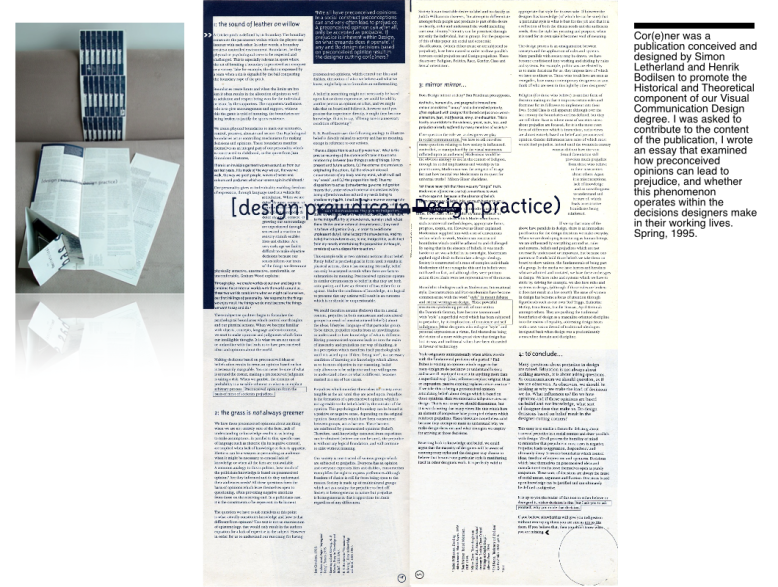
I was asked to take on the role of author by two fellow students, who wanted to produce a publication that raised awareness of the Historical and Theoretical Studies (HATS) component of our course. This was my first writing commission and I was not in control of the form those words would take on the page, I remember the feeling, on being handed the printed publication, and questioning in my mind, the typographic decisions and layout. Overall I felt proud my essay was included, although upon re-reading, clichés abound and there is an overall purple hue, something an editor would have remedied.

The experience of writing for a publication, and having my words shaped by another, provided me with a grounding that proved valuable in approaching my next project. Our Course Leader at Ravensbourne, Teal Triggs, was asked by Anne Burdick if students would like to be involved in a special edition of Emigre magazine. Mouthpiece was a two-issue project initiated and guest-edited by Burdick. It began with a call for papers and/or projects that posed the question, “What happens when the worlds of writing and design coincide, overlap and collide?”
Teal asked fellow student Simon Letherland and myself if we would like to take up the challenge of designing a text written by Brian Schorn. We met with Teal and she presented us with a facsimile of Brian’s essay. I hadn’t read anything like it before. This experiment in Potential Literature was baffling at first, we spent days, turning into weeks dissecting the text, interpreting and making marks that sought to make sense of its complexities. The result was a design that after much development met with Brian’s approval. However it was our modernist design education that led us to the solution that made the most sense, and as a result the design was unlike anything else in both issues, something I considered a success.
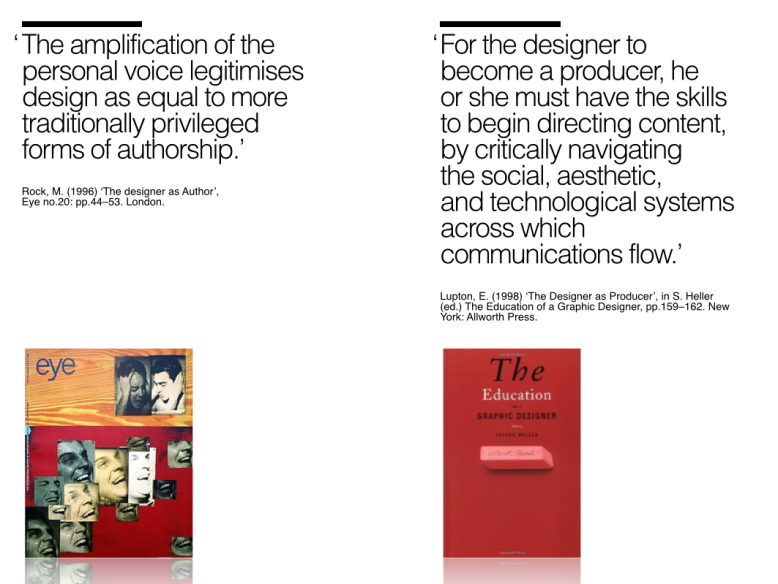
Throughout the 1990s graphic design discourse began to focus on authorship, and critically examined in a 1996 essay in Eye magazine. Michael Rock (1996:44-53) states ‘Authorship has become a popular term in graphic design circles, especially in those at the edges of the profession: the design academies and the murky territory between design and art. The word has an important ring to it, with seductive connotations of origination and agency. But the question of how designers become authors is a difficult one. and exactly who qualifies and what authored design might look like depends on how you define the term and determine admission into the pantheon.’
Rock asks if the designers role as ‘faceless facilitator’ (those who subscribe to modernist design principles) can be overthrown, exploring theories of authorship posited by Barthes (1968), Foucault (1969), de Man (1973), Truffaut (1954) and Sarris (1962). Rock suggests ‘the artist’s book offers a form of design authorship from which function has been fully exorcised. The artist’s book, in general, is concrete, self-referential and allows for a range of visual experiments without the burden of fulfilling mundane commercial tasks.’ However its reliance on poetics as opposed to practicality has been a turn off for designers. Likewise he sees activist design problematic in terms of who is speaking, the individual or the organisation?
Rock cites the now defunct Emigre magazine as a model where ‘content is deeply embedded in the form – that is, the formal exploration is as much the content of the magazine as the writing. VanderLans expresses his message through the selection of the material (as an editor), the content of the writing (as a writer) and the form of the pages and typography (as a form-giver).’
In his conclusion Rock questions whether the clamour for authorship by designers is limiting, appropriating Foucault’s question, what does it matter who is speaking, he says ‘If we really want to go beyond the designer-as-hero model, we may have to imagine a time when we can ask, ‘what difference does it make who designed it?’
In his essay Fuck Content, Rock (2009) says his ideas in calling for designers to become authors was misinterpreted, he was not calling for designers to generate content. He cites Beatrice Wardes Crystal Goblet metaphor as a nauseous false dichotomy, ‘it’s all about the wine’. Rock rejects the author-led stance and returns to auteur theory as a more likely explanation of how design is content in itself, stating ‘we speak through our assignment, literally between the lines’ and concluding with Roger Eberts maxim “It’s not what a movie is about, it’s how it is about it.”
In her essay ‘The Designer as Producer, Ellen Lupton drew upon Walter Benjamin’s 1934 essay “The Author as Producer,”. Lupton (1998) says ‘the text attacked the conventional view of authorship as a purely literary enterprise. He exclaimed that new forms of communication–film, radio, advertising, newspapers, the illustrated press–were melting down traditional artistic genres and corroding the borders between writing and reading, authoring and editing.’
Based on Benjamin’s Marxist leanings, Lupton suggests that the desktop technologies that democratised design in the mid 1980s brought the previously separate roles of design production back into the design process, thus ‘the proletarianization of design offers designers a new crack at materialism, a chance to re-engage the physical aspects of our work. Whereas the term “author,” like “designer,” suggests the cerebral workings of the mind, production privileges the activity of the body. Production is rooted in the material world. It values things over ideas, making over imagining, practice over theory.’
Lupton calls for design educators ‘to help designers become the masters, not the slaves, of technology. There exist opportunities to seize control– intellectually and economically–of the means of production, and to share that control with the reading public, empowering them to become producers as well as consumers of meaning.’

In the period 1995 to 2008 I worked in the design industry, as typified by the service-led model, three years employed with little client contact, and heavily directed designers in senior roles. I became self-employed in 1999 which meant that I could work directly with clients, and share the roles and responsibilities of design production with my partner. However there was little room for self-authored work, the most significant project in that period came in 2000 when I contributed to Zed issue 7 Public and Private, guest edited by Teal Triggs and Siân Cook of the Women’s Design Research Unit (WD+RU). This project allowed me to write content and to shape it, on this occasion editing was rigorous and in terms of approving the subject, direction and written content.

In 2008 I enrolled part-time on the MA Design Writing Criticism course at London College of Communication, the first of its kind in Europe, and this provided me with a platform to explore and interrogate the role of author and designer, and in the spirit of the Emigre publication, see how the two collide. It was a small group, only eight of us, we were joined the following year by seven full-time students.
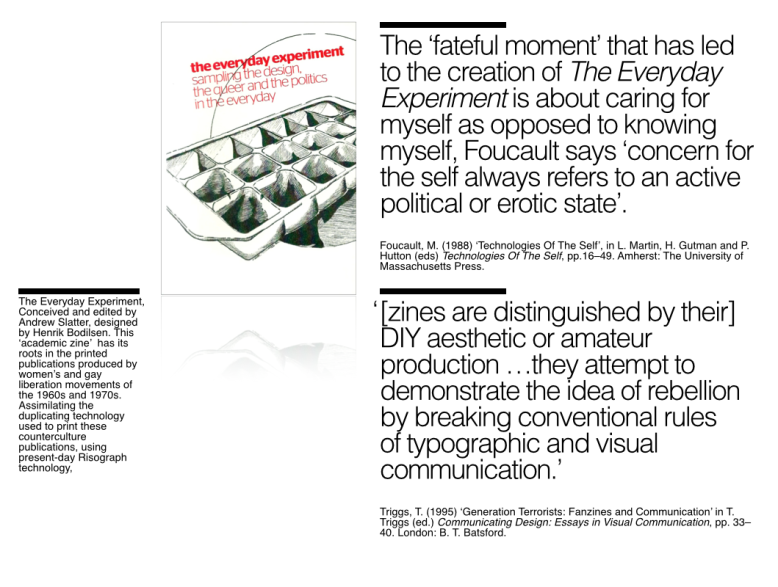
For the final major project I created a publication that would allow me to unite the schism between my modernist design beliefs and my sexuality, I acted very much in the spirit of designer as producer, directing content. This is a reflexive stance, and has parallels with the ‘auteur’, one which Rock (1996) rejected in favour of the designer-author model where ‘the amplification of the personal voice legitimises design as equal to more traditionally privileged forms of authorship’. As Foucault (1988) suggests the course facilitated the opportunity for the first time in my professional career to ‘care for myself’, the purely service-based model has never satisfied me, and never will.
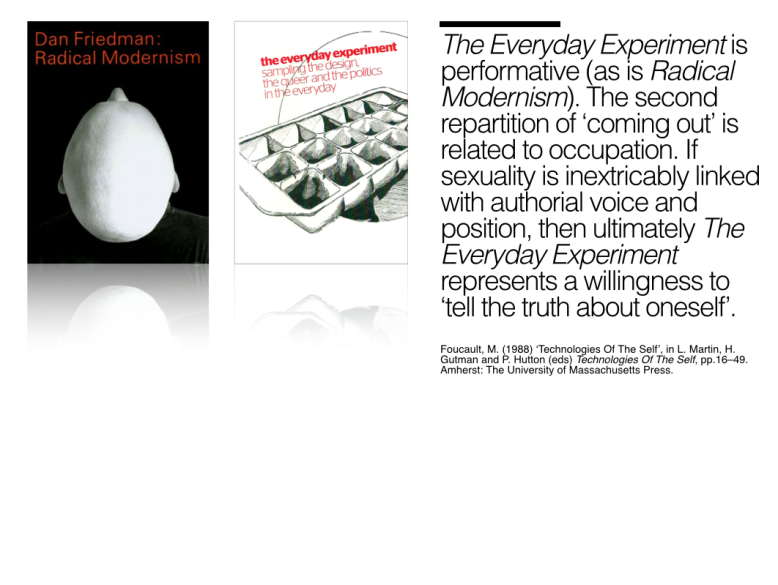
In his book Graphic Design and Postmodernism, Rick Poynor (2003) suggests that ‘Friedman’s idea of Radical Modernism was perhaps too personal, too much bound up in his own practice as designer and artist, to catch on with other designers, his visual strategies were often seen at this time in the work of those who sought to contest, in Frederick Jameson’s phrase, “the cultural logic of late capitalism”’. My alignment with Radical Modernism is personal, the ‘personal is political’ its precisely because its personal that it is radical.
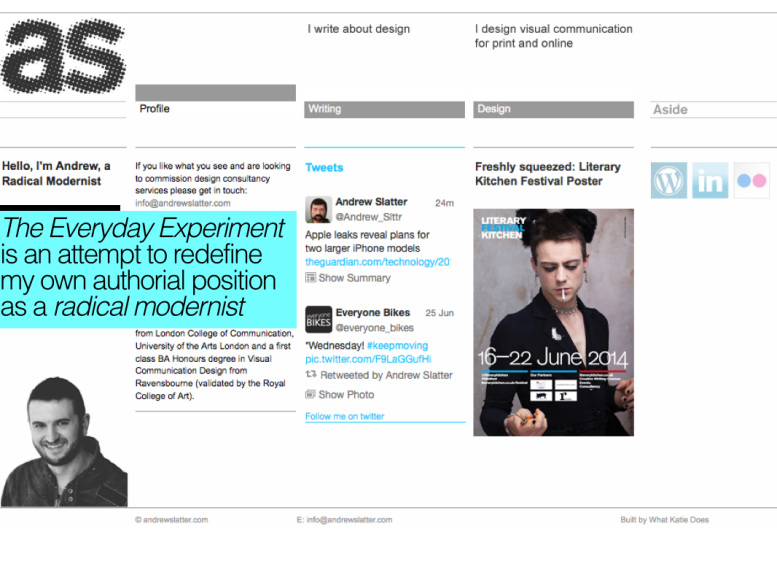
My website makes clear this position and whether or not audiences chose to enquire about this stance, it irrelevant, it is the catalyst, the uniting of author and designer in an ideology that marries the subjective with the objective, it is this agency that enables me to write.
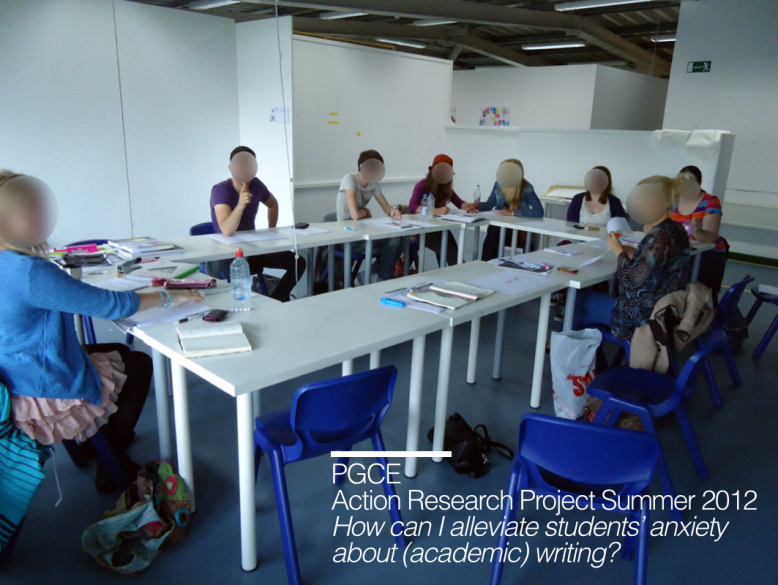
Teacher training provided an opportunity to undertake some action research into the relationship between writing and design via a Contextual and Theoretical Studies programme.

I often feel a sense of anxiety in anticipation of starting to write, having spent five years supervising and marking student essays and speaking to students in tutorials, it seems design students share this trait.
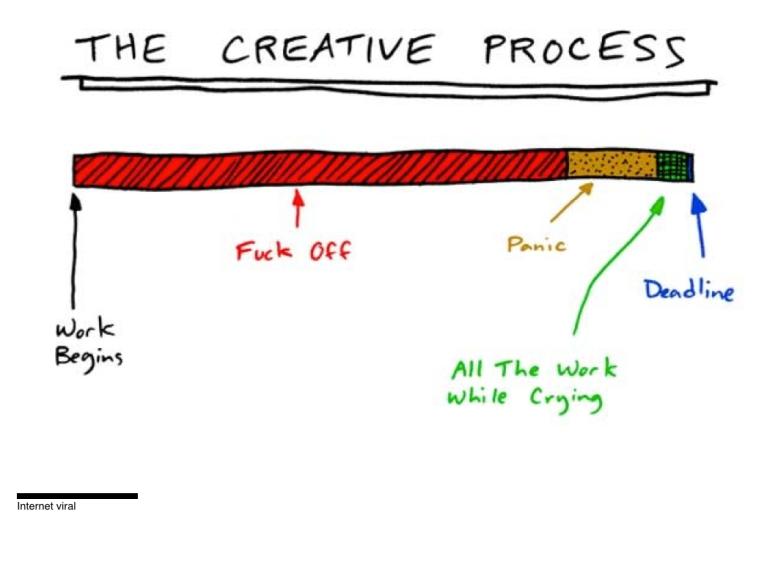
While Francis’s (2009) panic to production model helpfully visualises the academic writing critical path, this anecdotal diagram suggests creatives tread a more precarious path. When presenting this diagram to the students in the workshops here at LCC about two weeks before the essay hand-in, there was laughter followed by collective resignation that most of them were entering the green phase.
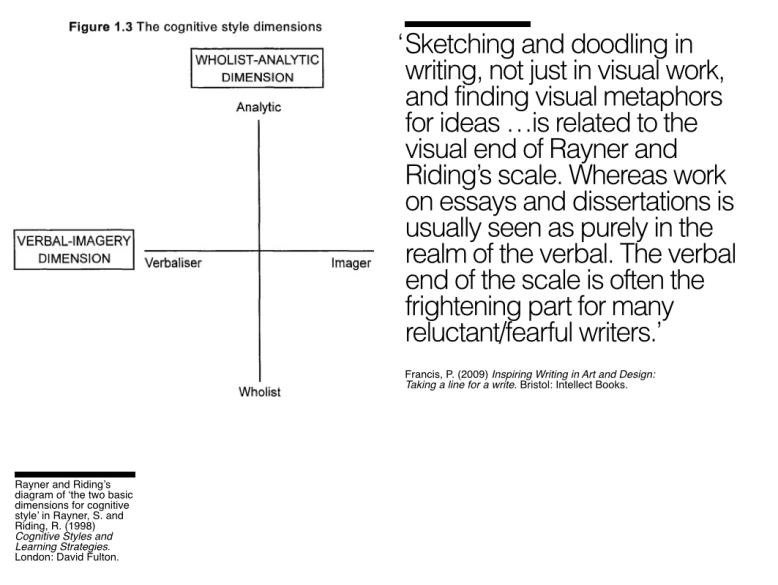
I have heard many times in Contextual and Theoretical Studies sessions that students regard themselves as ‘visual’ learners. Through writing workshops such as the one I undertook with second year degree students, they challenged this self perception, and began to think of writing as a creative activity.
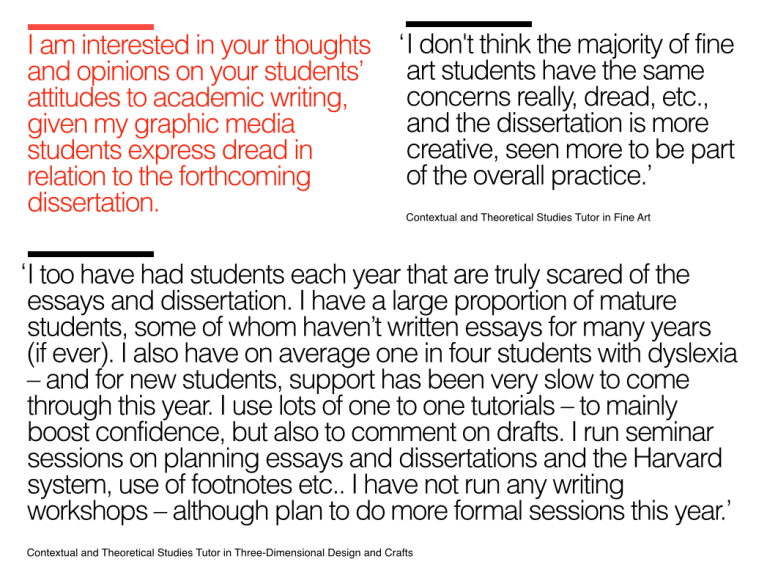
I found responses from colleagues enlightening, fine artists see writing as part of their creative practice, design students less so.
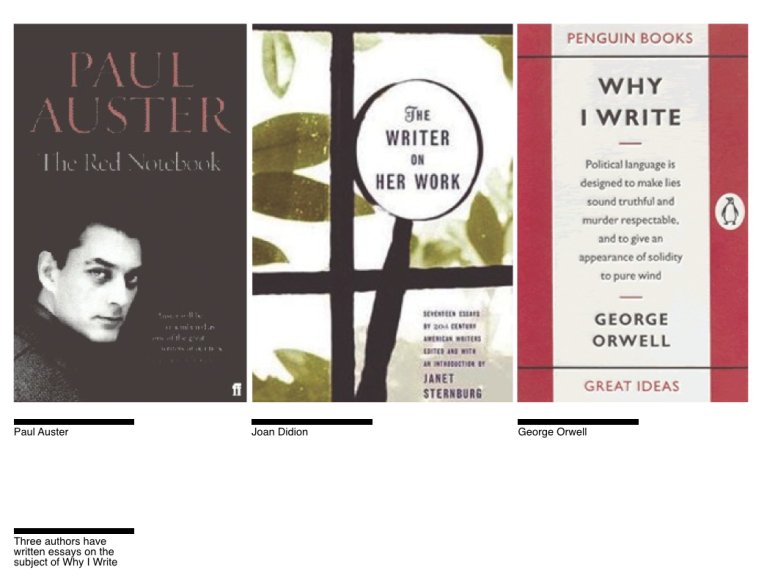
The first exercise we were asked to complete before the first class on the MA Design Writing Criticism course was to write 250 words on the subject of Why I Write. We were then given three ‘Why I Write’ texts by Auster, Didion and Orwell then re-write our 250 words for the following week.
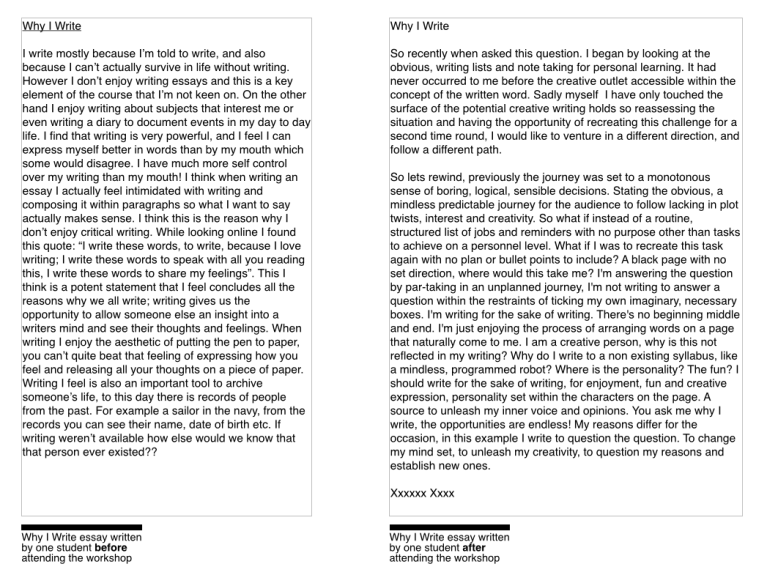
I asked my PGCE writing workshop research group to do the same, here are two examples one pre- and one post-workshop.

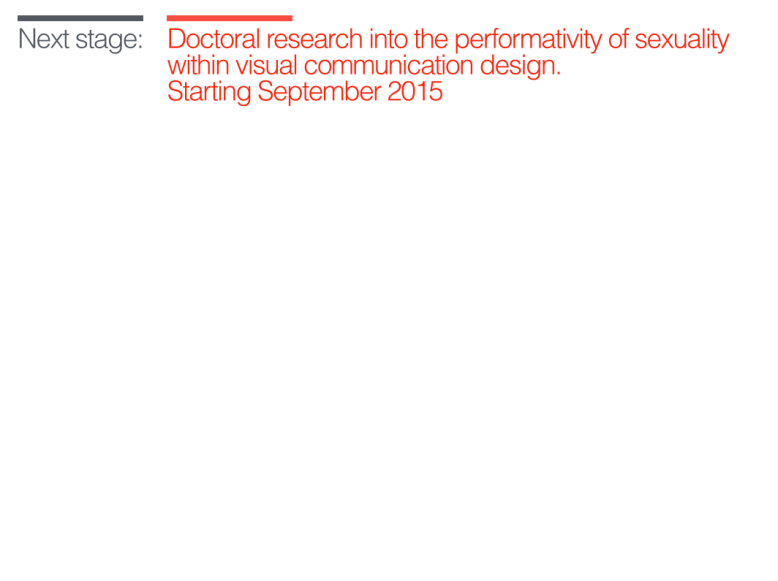
References
Barthes, R. (1968) ‘The Death of the Author’ in S. Heath (trans) Image, Music, Text, pp. 142–148. Hill and Wang: New York.
de Man, P. (1973) ‘Semiology and Rhetoric’ in Textual Strategies, op. cit, p121 in Harari, J. (Ed) (1979) Textual Strategies , Ithaca: Cornell University Press.
Foucault, M. (1969) ‘What Is an Author?’, in C. Harrison and P. Wood (eds)Art in Theory, 1900–2000: An anthology of changing ideas, pp. 949–943. Malden, Massachusetts: Blackwell Publishing.
Foucault, M. (1988) ‘Technologies Of The Self’, in L. Martin, H. Gutman and P. Hutton (eds) Technologies Of The Self, pp. 16–49. Amherst: The University of Massachusetts Press.
Francis, P. (2009) Inspiring Writing in Art and Design: Taking a line for a write. Bristol: Intellect Books.
Friedman, D. (1994) Radical Modernism,
New Haven & London: Yale University Press.
Lupton, E. (1998) ‘The Designer as Producer’, in s. Heller (ed.) The Education of a Graphic Designer, pp. 159–162. New York: Allworth Press.
Poynor, R. (2003) No More Rules: Graphic Design and Postmodernism. London: Laurence King.
Rock, M. (2009) Fuck Content. http://2×4.org/ideas/2/fuck-content/
Rock, M. (1996) ‘The designer as Author’,
Eye no.20: London.
Sarris, A. (1962) ‘Notes on the Auteur Theory’ in Adams Sitney, P. (Ed) (1970) Film Culture reader. New York: Praeger Publishers.
Truffaut, F. (1954) ‘A Certain Tendency for the French Cinema’ in Cahiers du cinéma, no. 31, January 1954
Filed under: Education, Visual Communication Design, Writing





